Even after a lifetime of having ADHD, I’m still learning about the unique quirks and paradoxes of my neurodivergent brain and nervous system.
One of the best tools I’ve found for improving my insight into my own ADHD brain is by reading the best ADHD books from prominent authors, experts and creators that are written for helping ADHD adults thrive.
I’ve discovered a series of ADHD book authors such as Edward M. Hallowell, Russel Barkley and Gabor Maté who have transformed the way I look at ADHD as well as creators like Jessie J. Anderson, Jessica McCabe and Tom Hartmann who understand the importance of a creative outlet for ADHD.
Here are some of my favourite insights and quotes from the best books on ADHD (in my humble opinion).
1. Driven to Distraction by Edward M. Hallowell and John Ratey
Dr. Hallowell is a psychiatrist with ADHD and the author of several best-selling books about ADHD. His first and best-known book is Driven To Distraction. He co-wrote this book with Dr. John Ratey, who has done pioneering research on the positive effect of exercise on ADHD brains.

“The Seven Habits of Highly Effective ADHD Adults:
1. Do what you’re good at. Don’t spend too much time trying to get good at what you’re bad at. (You did enough of that in school.)
2. Delegate what you’re bad at to others, as often as possible.
3. Connect your energy to a creative outlet.
4. Get well enough organized to achieve your goals. The key here is “well enough.” That doesn’t mean you have to be very well organized at all—just well enough organized to achieve your goals.
5. Ask for and heed advice from people you trust—and ignore, as best you can, the dream-breakers and finger-waggers.
6. Make sure you keep up regular contact with a few close friends.
7. Go with your positive side. Even though you have a negative side, make decisions and run your life with your positive side.”
“While we all need external structure in our lives—some degree of predictability, routine, organization—those with ADD need it much more than most people. They need external structure so much because they so lack internal structure.”
“Russell Barkley similarly describes the primary problem in ADD as a deficit in the motivation system, which makes it impossible to stay on task for any length of time unless there is constant feedback, constant reward.”
“For all the hoopla you read and hear about the overdiagnosis of ADD and the overuse of medication-indeed, serious problems in certain places—the more costly problem is the opposite: millions of people, especially adults, have ADD but don’t know about it and therefore get no help at all.”
2. Taking Charge of Adult ADHD by Russell A. Barkley
Dr. Russel Barkley is a doctor and researcher specializing in ADHD in children. He has written several studies and delivered a series of popular talks about ADHD treatment options.
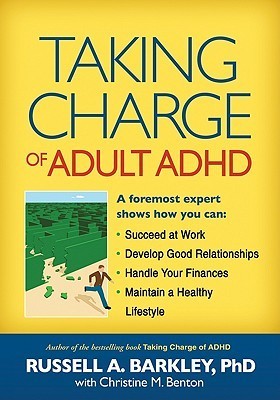
“ADHD is not a disorder of knowing what to do, it’s a disorder of doing what you know — at the right times and places.”
― Dr. Rusell Barkley
“Anyone who exhibits the classic symptoms of ADHD will have difficulty with all or most of the seven core executive functions.”
― Russell Barkley, Ph.D.
“Rule 1: Stop the Action! Buy some time before you respond.
Rule 2: See the Past … and Then the Future See what’s coming.
Rule 3: Say the Past … and Then the Future Analyze before deciding; develop rules for the future.
Rule 4: Externalize Key Information Rely on something besides your memory.
Rule 5: Feel the Future Stay motivated.
Rule 6: Break It Down … and Make It Matter Bring the future a lot closer.
Rule 7: Make Problems External, Physical, and Manual Simplify problem solving.
Rule 8: Have a Sense of Humor! Accept your imperfections and get on with your life.”
― Russell Barkley, Ph.D.
“The children who need love the most will always ask for it in the most unloving ways”
― Russell Barkley, Ph.D.
“The brighter people struggle with the disorder longer, they’re not believed, nobody can think they got as far as they did and have ADHD.”
― Russell Barkley, Ph.D.
“ADHD is, to summarize it in a single phrase, time blindness… People with ADHD cannot deal with time; and that includes: looking back, to look ahead to get ready for what’s coming at you. (…) The now is more compelling than the information you’re holding in mind.”
― Russell Barkley, Ph.D.
3. How to ADHD: An Insider’s Guide to Working with Your Brain by Jessica McCabe
Jessica McCabe is a prolific creator with ADHD and the biggest ADHD YouTuber who has a unique perspective on ADHD focus, motivation and the creator lifestyle.
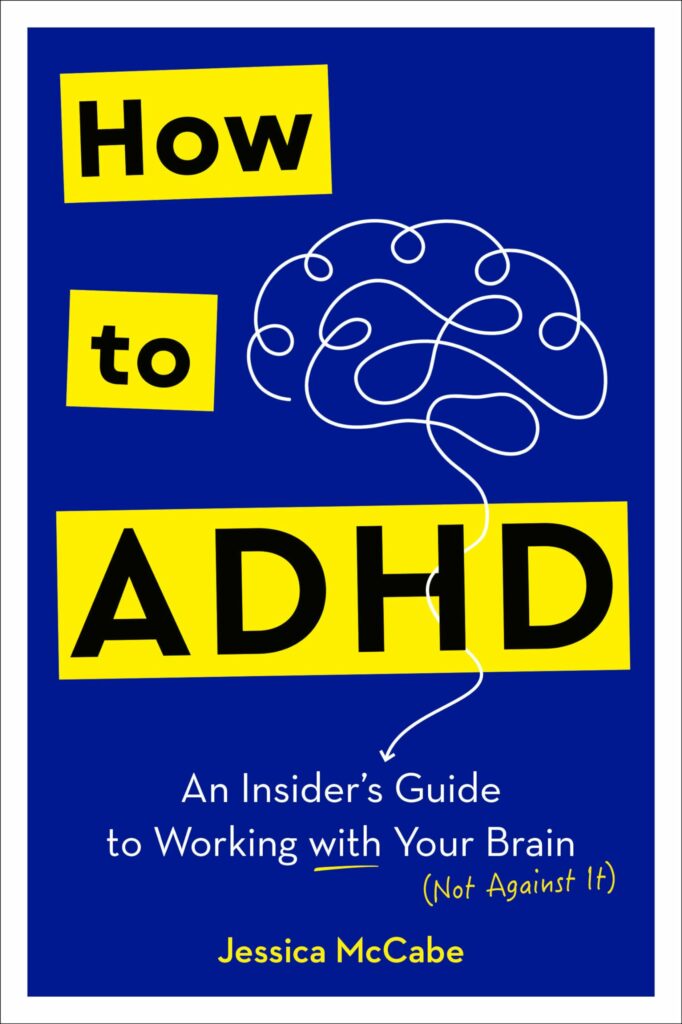
“The fact that I could sometimes exceed expectations made it even more frustrating for me—and everyone around me—when I failed to meet the basic ones.”
“Not only have I had friends give up on me for being unreliable, I’ve also had relationships go south because I can’t keep track of how I’m being treated. Is this friend saying something unkind for the first time or the fiftieth? What was that last fight about, anyway? Forgetful people—particularly those of us with low self-esteem (see above)—can be easy to manipulate.”
“We are here to learn. We make space for differences. And we allow all voices a chance to be heard.”
“You can’t pick your friends. You can only pick who to do stuff with that you find meaningful. And then see what kind of relationship evolves over time.”
“So we learn to mask our ADHD behaviors and do what’s expected of us—be quiet, sit still, pay attention—when we’re in public. We pay the price later—melt down, feel exhausted, stare blankly at a wall, or scroll through social media for hours just trying to recharge”
“My community’s encouragement inspired me to make a video about how success isn’t about avoiding failure—it’s about continuing despite it.”
“What we lack is the ability to regulate our attention.”
4. Extra Focus: The Quick Start Guide to Adult ADHD by Jesse J. Anderson
Jesse J. Anderson is an ADHD creator and advocate for mental health who runs a popular YouTube channel and email newsletter.
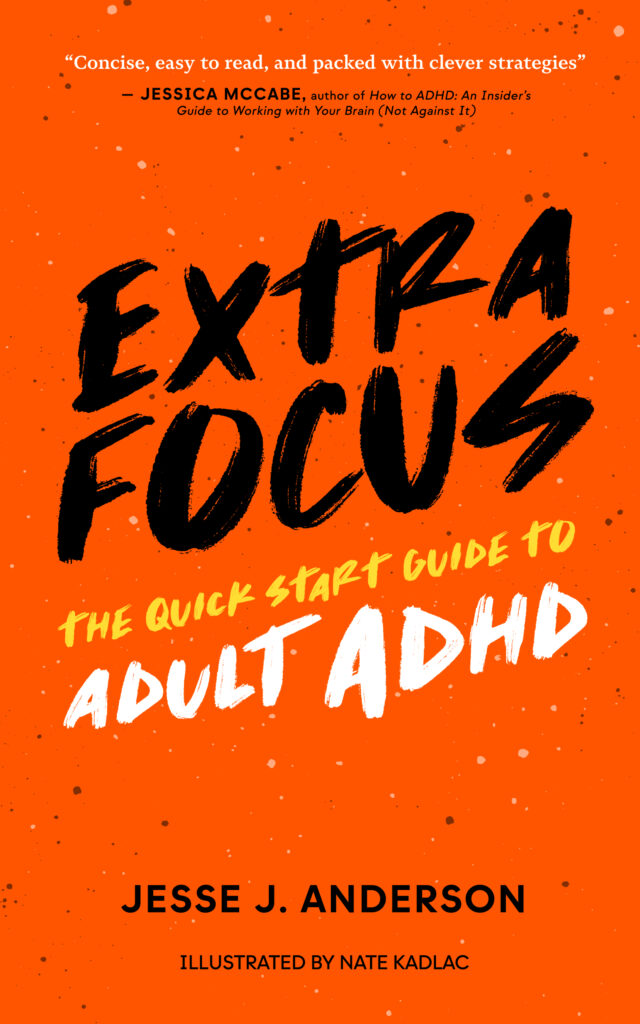
“The problem is that everyone expects you to be motivated by the same things that motivate others.”
“Captivate: how can I make it interesting? Create: how can I make it creative or novel? Compete: how can I make it competitive or challenging? Complete: how can I make its completion feel urgent?”
“Stop using outcome-based goals, which are typically framed like this: “I’m going to finish writing this paper today.” “I’m going to clean the entire office this weekend.” “I’m going to do my taxes tonight.” These types of goals set you up for failure because your estimates often aren’t accurate. Then you get frustrated with your lack of progress, which further demotivates you. Instead, use time-based goals: “I’m going to write for one hour.” “I’m going to clean for twenty minutes.” “I’m going to work on my taxes until 8 p.m.”
“You assume everyone experiences these things at the same intense level that you do: excitement, fear, pain, joy, distress, panic. In fact, you’re often surprised and confused when people think you’re being “a bit much” when it’s just the way you naturally act.”
“Most people (often called neurotypical people) are motivated primarily by three key factors: importance, rewards, and consequences. When something is important, they move it to the top of their to-do list.
The same goes for tasks with significant rewards or consequences. Most productivity strategies and systems are built with this in mind.
This can lead people with ADHD into believing three big myths about how motivation works for us.
ADHD Motivation Myths
1. If something is important to you, you will do it.
2. Increasing a reward will increase your motivation.
3. Harsher consequences will give you more willpower.
Rewards and consequences that are immediate can sometimes motivate, but delayed rewards don’t really motivate us at all. We can’t simply “try harder” and force these things to work. We need to approach our motivation in a different way, a way that is compatible with our brain.
Specifically, one of the greatest challenges we face is task initiation—actually getting started on a task. Moving thought into action.”
“Dr. William Dodson, a board-certified psychiatrist who was one of the first practitioners to specialize in treating adults with ADHD, suggests people with ADHD have a different nervous system than neurotypical people. He theorizes that while most people have an importance-based nervous system, people with ADHD have an interest-based nervous system. They primarily find motivation through interest, novelty, challenge, and urgency.”
“The 4 Cs are a handy template to help you put your motivation into gear. Before you start something, ask yourself the following questions: Captivate: how can I make it interesting? Create: how can I make it creative or novel? Compete: how can I make it competitive or challenging? Complete: how can I make its completion feel urgent?”
“Here’s the formula: To get started on [important task/ project], I can use [captivate, create, compete, complete] to ignite my motivation and build momentum.”
“One great paradox of having ADHD is your relationship with structure. It’s essential to help us manage our lives, yet we have a strong tendency to resist it. I know I need it, but structure just feels so confining!
So if we want to work in synergy with our brains, we have to tackle structure head-on. We can do this by working with our brain’s natural rhythm. The systems and routines we use should feel empowering rather than limiting.
To that end, we can avoid the constricting feeling of structure by building around positive habits. Take reward-seeking. If I do the dishes and my wife gives me a kiss and tells me, “Great job!” I’m going to be a lot more likely to repeat that behavior!
The next time I think about the dishes, I’ll remember the positive vibes I got the last time I did them, which makes me more likely to get to work. That encouragement creates a positive feedback loop. You take a positive action, get some sort of positive result, and teach your brain that this is a good thing to do. It’s that simple.”
5. Scattered Minds: The Origins and Healing of Attention Deficit Disorder by Gabor Maté
Gabor Maté is a Canadian doctor who was diagnosed with ADHD in his fifties and he is an advocate for ADHD and trauma awareness and author of Scattered Minds: How Attention Deficit Disorder Originates and What You Can Do About It.
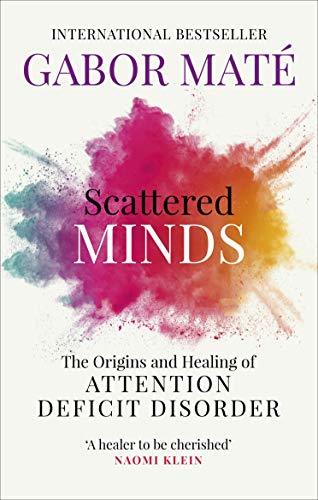
“I do not believe ADD leads to creativity any more than creativity causes ADD. Rather, they both originate in the same inborn trait: sensitivity. For creativity, a temperamental sensitivity is indispensable. The sensitive individual, as we have seen, draws into herself the unseen emotional and psychic communications of her environment. On some levels of the unconscious, she will, therefore, have a deeper awareness of the world. She may also be more attuned to particular sensory input, such as sound, color or musical tone. Thus the sensitivity provides her with the raw materials her mind will rework and reshape. Thus sensitivity contributes to the emergence of attention deficit disorder, as well as to creativity.”
“To paraphrase Nietzsche, even the wrong turns and side roads have meaning and purpose, if only to teach us which way the path to oneself does not lie.”
“The warmth and satisfaction of positive contact with the adult is often just as good as a psychostimulant in supplying the child’s prefrontal cortex with dopamine. Greater security means less anxiety and more focused attention. The unseen factor that remains constant in all situations is the child’s unconscious yearning for attachment, dating back to the first years of life.”
“We do not have to look for diseases to explain why some people are not able to experience the full flowering of their potential. We have only to inquire what conditions sustain unfettered human development and what conditions hinder it. The answer to underdevelopment is development, and for development the appropriate conditions must exist. No matter how efficiently they are able to arouse the higher brain centers, medications offer only a partial solution to the problems posed by ADD. We may not be able to prescribe development directly, but we can promote an environment that makes development possible.”
“The effects of disrupted family life on mental functioning are magnified by cultural influences. “American society,” Drs. Hallowell and Ratey observe, “tends to create ADD-like symptoms in all of us. We live in an ADD-ogenic culture.” They identify what they call “pseudo ADD,” people living lives in conformity with the frenzied society and culture around them but not impaired in their functioning by the neurophysiological attributes of ADD. It can look like ADD from the outside, but it is not ADD from within. What are some of the hallmarks of American culture that are also typical of ADD? The fast pace. The sound bite. The bottom line. Short takes, quick cuts. The TV remote-control clicker. High stimulation. Restlessness… Speed. Present-centered, no future, no past. Disorganization… Going for the gusto. Making it on the run. The fast track. Whatever works. Hollywood. The stock exchange. Fads…”
“The world is much more ready to accept someone who is different and comfortable with it than someone desperately seeking to conform by denying himself.”
“Given their automatic tuning out, ADD children forever find themselves being told to “pay attention”—a demand that completely misunderstands both the nature of the child and the nature of attention. The obvious monetary connotation of “pay” is that attention is something the child owes the adult, that the child’s attention belongs to the adult by right. The phrase takes for granted that being attentive is always a consciously chosen act, subject to one’s will. Both of these assumptions are faulty.”
“The use of rewards—what might be called positive coercion—does not work in the long run any better than threat and punishment, or negative coercion. In the reward, the child senses the parent’s desire to control no less than in the punishment. The issue is the child’s sense of being forced, not the manner in which the force is applied. This was well illustrated in a classic study using magic markers.2 A number of children were screened to select some who showed a natural interest and inclination for playing with magic markers. Those who did were then divided into three different groups. For one group, there was no reward involved and no indication what to do with the markers. Another group was given a small reward to use the markers, and the third was promised a substantial reward. When retested sometime later, the group that had been most rewarded showed the least interest in playing with the magic markers, while the children who had been left uninstructed showed by far the greatest motivation to use them. Simple behaviorist principles would suggest it ought to have been the other way around, another illustration that behavioral approaches have no more than short-term efficacy. At work here, of course, was residual counterwill in response to positive coercion. In a similar experiment, the psychologist Edward Deci observed the behaviors of two groups of college students vis-à-vis a puzzle game they had originally all been equally intrigued by. One group was to receive a monetary reward each time a puzzle was solved; the other was given no external incentive. Once the payments stopped, the paid group proved far more likely to abandon the game than their unpaid counterparts. “Rewards may increase the likelihood of behaviors,” Dr. Deci remarks, “but only so long as the rewards keep coming… Stop the pay, stop the play.”
The DSM … defines attention deficit disorder by its external features, not by its emotional meaning in the lives of individual human beings.
“It is impossible to understand addiction without asking what relief the addict finds, or hopes to find, in the drug or the addictive behaviour.”
6. ADHD 2.0 by Edward M. Hallowell and John Ratey
Another excellent book by Dr. Hallowell and John Ratey that came out in the last year or so. It simplifies and updates a lot of interesting research and ADHD strategies covered in Driven To Distraction.
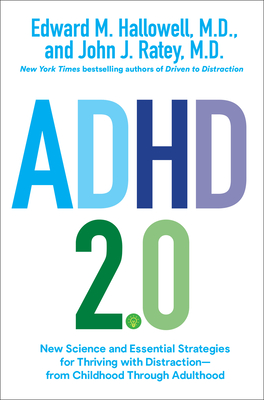
“A person with ADHD has the power of a Ferrari engine but with bicycle-strength brakes. It’s the mismatch of engine power to braking capability that causes the problems. Strengthening one’s brakes is the name of the game.”
“it helps to think of ADHD as a complex set of contradictory or paradoxical tendencies: a lack of focus combined with an ability to superfocus; a lack of direction combined with highly directed entrepreneurialism; a tendency to procrastinate combined with a knack for getting a week’s worth of work done in two hours; impulsive, wrongheaded decision making combined with inventive, out-of-the-blue problem solving; interpersonal cluelessness combined with uncanny intuition and empathy; the list goes on.”
“Make friends with structure, make friends with organization. We tend to see them as the enemy because, because we think that is going to inhibit our creativity. And so we resist structure. Oh no, that’s for boring people that have attention surplus disorder. I’m free; I have ADD. Big mistake. Structure, in fact, potentiates creativity. Structure sets you free.”
“My favourite examples are Shakespeare and Mozart — two of the most creative geniuses who ever lived. Shakespeare wrote within incredibly tight forms, blank verse, iambic pentameter, de da, de da, de da, de da. Within that structure he created infinite variety; he created extraordinary variety but, but he needed that structure.”
“People with ADHD have a Ferrari for a brain, but they have bicycle brakes. Strengthen the breaks and you have incredible power. People with ADHD are creative and imaginative. They’re the people who colonized this country. They are visionaries, pioneers, dreamers, and risk-takers. It’s an edge.”
“They think along unusual lines and feel a persistent drive to build, develop, or create something, anything, from a business to a boat to a book to a balustrade. It’s like an omnipresent itch to make something. If that itch goes unscratched, we tend to feel listless or depressed, unmotivated and at sea. If we pour our energies into something that is beneath our creative abilities, we tend to lose interest. Remember, boredom = kryptonite. If we find ourselves in a job that doesn’t draw on that creative strength but instead demands a skill set we just don’t have, we will falter—and we’ll feel the crush of that defeat harder than others do.”
7. The Mindfulness Prescription for Adult ADHD by Lidia Zylowska
Lidia Zylowska is a doctor of psychiatry and an internationally recognized expert in adult ADHD and mindfulness-based therapies. She is an advocate for an integrative holistic medicine approach to ADHD.
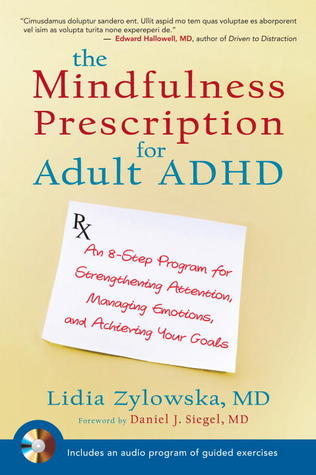
“Any change and growth starts with awareness.”
“Strategies that relax and replenish can restore one’s reservoir of willpower and are thus helpful in ADHD. These strategies include: times of relaxation such as meditation, positive emotions, self-talk that is encouraging, time of play, physical exercise, adequate breaks, or even having a snack that increases blood glucose. Motivational strategies such imagery, or physical reminders of or talking about future rewards can also help.”
“Step 1. Become More Present: Attention and the Five Senses
Step 2. Focus the Wandering Mind: Mindful Breathing
Step 3. Direct and Anchor Your Awareness: Mindfulness of Sound, Breath, and Body
Step 4. Listen to Your Body: Mindfulness of Body Sensations and Movement
Step 5. Observe Your Mind: Mindfulness of Thoughts
Step 6. Manage Your Emotions: Mindfulness of Feelings
Step 7. Communicate Skillfully: Mindful Listening and Speaking
Step 8. Slow Down to Be More Effective: Mindful Decisions and Actions”
8. Small Talk: 10 ADHD Lies And How To Stop Believing Them by Richard and Roxanne Pink
Richard and Roxanne Pink are the authors of the best-selling book Dirty Laundry, an empowering and witty guide to banishing shame and living your fullest life with ADHD. Small Talk is the sequel to this book and it’s one of my favourite books about adult ADHD.
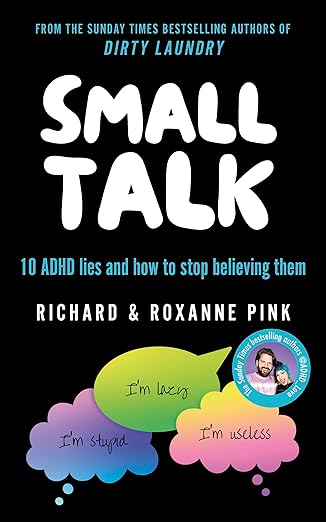
“So many adults are now figuring out that they have ADHD and suddenly realising why life has been so hard. And they’re mourning the life they could have had. Grieving the hard years they have had to fight to make it through. It’s an important part of the process. And so is dreaming. And hoping—that their talents, interests, creativity and potential can be realised.”
“Accepting that an ADHD partner is going to piss you off sometimes is actually extremely healthy. There is nothing wrong with getting frustrated. It’s how we deal with the frustration.”
“How about I put you on trial for your lack of creativity, special interests, and empathy? How about I roll my eyes at you when you can’t write a book, or start a creative business, or immediately know what is going on under the stoic expression of a loved one? It wouldn’t be fair, would it? To judge you as a failure because you don’t possess the same skills as me?”
“So many adults are now figuring out that they have ADHD and suddenly realising why life has been so hard. And they’re mourning the life they could have had. Grieving the hard years they have had to fight to make it through. It’s an important part of the process. And so is dreaming. And hoping—that their talents, interests, creativity and potential can be realised.”
“In all honesty, ADHD is a terrible name for it. I don’t have a deficit of attention; as I said in Dirty Laundry, I have the total opposite: a wild, uncontrollable attention. My biggest struggle isn’t trying to focus, or that I lose things, or struggle with time. It’s actually the chronically low self-esteem about my abilities I have been living with my whole life, and all of the negative core beliefs that I hold.”
9. ADHD: A Hunter in a Farmer’s World by Tom Hartmann
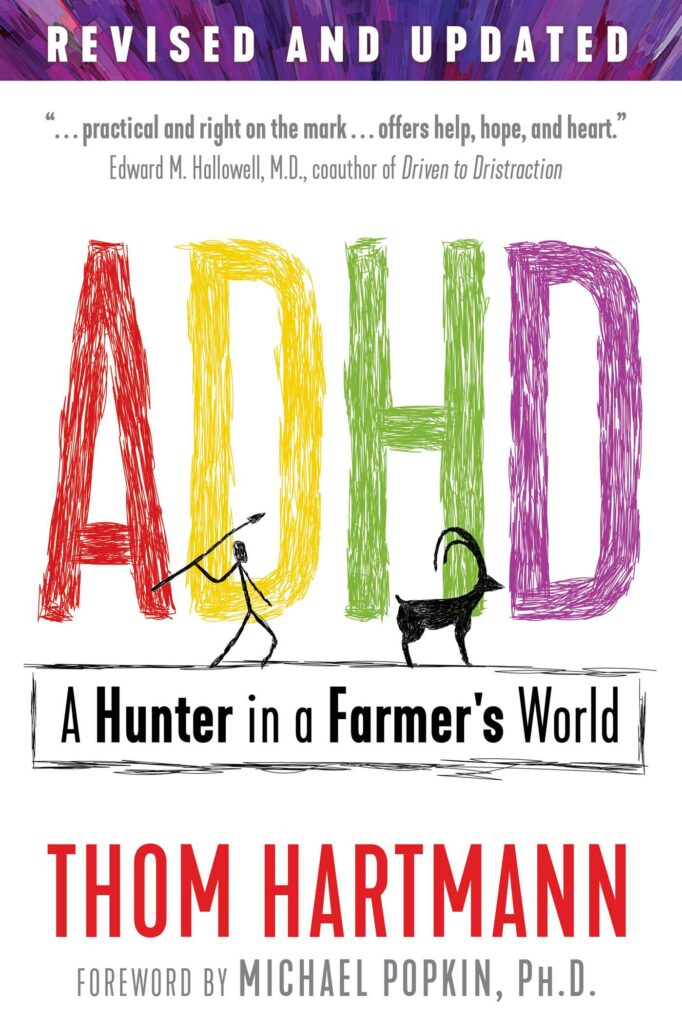
The truth is that ADHD isn’t a disease at all. Regarding it as such further damages people with ADHD who already live in a soceity that simplify isn’t built for them.
“If you are an adult who has experienced chronic issues with restlessness, impatience, poor listening skills, or a difficulty doing ‘boring’ jobs … you already know what it feels like to experience some of the challenges associated with ADHD.”
“ADHD is characterized by three primary behaviors (sometimes referred to as “the three-legged stool”), those being distractibility, impulsivity, and stimulation-seeking behaviors.”
“If we are to achieve a richer culture, rich in contrasting values, we must recognize the whole gamut of human potentialities, and so weave a less arbitrary social fabric, one in which each diverse human gift will find a fitting place.”
10. Your Brain’s Not Broken: Strategies for Navigating Your Emotions and Life with ADHD by Tamara Rosier
Tamara Rosier is a recognized expert and speaker about adult women with ADHD who is the founder of the ADHD Center of West Michigan.
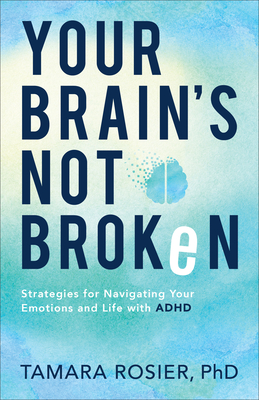
“The results of the experiment suggest that, for those with ADHD, anticipation of a reward means nothing to their striatum. It takes the actual rewards or fun events to light up the striatum with excitement.3 But for people who don’t have ADHD, even before the actual rewards arrive, the striatum is buzzing with activity in response to signals that promise rewards will be coming.”
“Today, when people say they “went down the rabbit hole,” they are usually referring to getting sucked into spending way too long reading about or researching something on the internet. For those of us with ADHD, though, rabbit holes are a description of our daily thought process as it takes twists and turns, tangents, and digressions.”
“Because we don’t have the filters to sift out unnecessary information, these distractions, which are nearly invisible to the neurotypical person, compete for our attention.”
“Why is this task in this quadrant? How will I begin? (Be very specific.) When will I do this? (Set a specific time to begin and end.) Where will I do this activity? What might be emotionally distracting to me while I work? How will I manage that? How will I guard myself against the malicious motivators?”
“There is a misconception that those with ADHD lack the ability to pay attention or stay focused. The reality is that ADHD causes us to pay too much attention to everything most of the time—especially when it comes from our environment. We may become easily distracted by irrelevant information that our five senses are detecting: people whispering, crooked artwork on the wall, perfume that is too strong, the itchy tag of our T-shirt, lights that are too bright. Because we don’t have the filters to sift out unnecessary information, these distractions, which are nearly invisible to the neurotypical person, compete for our attention. Because of our brains that go ping! our attention is often inefficiently redirected.”
“Hyperfocus Conversely, sometimes it will look like those of us with ADHD can actually sustain focus, but it’s not a normal type of focus. When we deeply and intensely concentrate on something that we find very interesting, we will unconsciously tune out any irrelevant thoughts and senses. This is a single-minded trancelike state called hyperfocus. It’s our way of tuning out the chaos inside and outside of our heads. Hyperfocus happens when we completely immerse ourselves in an intriguing task, like working out complicated math problems or editing photos and film.”
“ADHD expert William Dodson explains that “the vast majority of adults with ADHD are not overtly hyperactive, though they are hyperactive internally.”1 For many of them, their hyperactivity feels more like an inner restlessness or agitation. They will likely worry about what may happen in the future. Like their outwardly hyperactive counterparts, they also have racing thoughts and a craving for excitement, but it occurs inwardly.
- 10 Tips, Tricks And Tools To Overcome ADHD Paralysis - March 19, 2025
- 10 Interesting Facts About Adult ADHD And Mental Health - March 18, 2025
- 15 Ways To Manage ADHD Without Meds By Biohacking Dopamine - February 14, 2025




